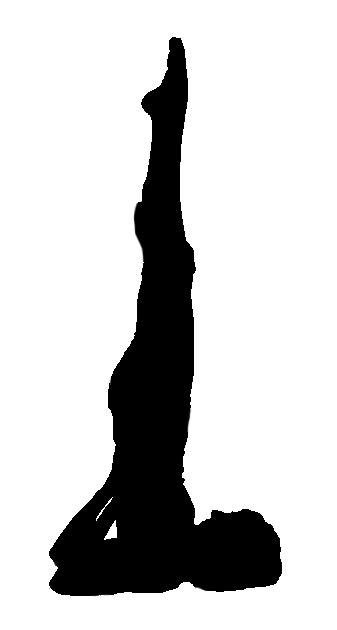[ Excerpt from The Science of Yoga, page 521 ]
In the Sanskrit language, sarva means "all" or "entire" and anga means "limb." Therefore, the literal translation of this asana would be "the pose of all the limbs."
Several non-literal translations exist as well for this pose, such as "the candle pose," "the complete pose," and the most commonly used "shoulder stand."
Technique
- Begin by laying on your back in shava asana.
- Inhale and raise the feet and legs slowly, keeping the legs together and as straight as possible.
- Pause in dwi pada utthana asana while you slowly exhale the air from the lungs.
- With another full inhalation, gradually lift the buttocks and trunk off of the floor so that the body becomes vertical with the weight supported on the shoulders.
Note: As you begin to raise the trunk up off the floor, place your hands onto the buttocks/lower back for support, with your elbows firmly planted on the floor. As the trunk is raised higher, gradually slide your hands up the back, continuing to support the lifting of the trunk.
- In the fully upright position, the chin should be tucked tightly in against the upper chest to stimulate the thyroid and parathyroid glands.
- The legs and feet should be held together and all the other unnecessary muscles in the body should be relaxed. Try to remain fixed in this position, with no movement.
Note: In the full position, the body from the shoulders to the feet must be completely straight (i.e., try to avoid bending at the hips). Slide the elbows closer together so that they remain approximately shoulder-width apart. Balance is ensured by the base of support formed by the shoulders and elbows.
Note: Great care should be taken in coming out of this position. The movement should be slow and controlled, with no flopping or dropping down to the floor as follows:
- On an exhalation, begin reversing out of the position by slowly lowering the upper torso back to the floor while sliding your hands down the back, finishing in dwi pada utthana asana (the double-leg lift position).
- Hold this position while you take in another full breath.
- Exhale and slowly lower the legs back down to the floor, finishing in shava asana.
Cautions
This asana SHOULD NOT be practised by anyone suffering from the following conditions without personal guidance from a guru:
- Serious heart disease
- High blood pressure
- Advanced sclerosis of the vessels in the brain
- Enlarged thyroid, liver or spleen
- Cervical spondylitis
Sarvanga asana should also be avoided when suffering from acute infections of the head and neck (such as sinusitis, abscesses), as well as during the later stages of pregnancy.
Effects and Benefits
This asana will save your doctor bills!! It is deemed by the yogis as the panacea for most common ailments and as a blessing offered to mankind by the ancient sages.
As one of our glandular stimulators, it has a very powerful effect upon the thyroid and parathyroid glands, helping to regulate and normalise their functions. Since the healthy functioning of all endocrine glands depend on a healthy thyroid, it is easy to see the importance and the wide range of positive effects of the practice of sarvanga asana...
[Continued...]
DISCLAIMER:
The contents of this web page are intended for informational purposes only. One should not engage in any yoga practices based solely upon the directions given on this web page or any other page of this web site. Anyone atempting to perform any of the yoga exercises introduced on this website assumes full responsibility and does so at their own risk.
---------------------
NOTE: This yoga article is an excerpt from The Science of Yoga, an online yoga training program with streaming yoga videos and 600 pages of step-by-step yoga instruction.

"The Science of Yoga is a course worthy of
leather binding and an honored place in the
finest libraries in the world
... It is indeed a masterful work."
Dr. John Michael Christian
AwakeningWithYoga.com
Learn More About
The Science of Yoga Course
|







